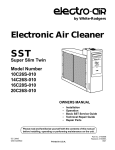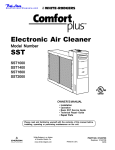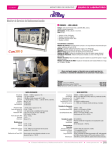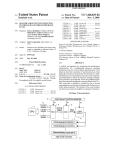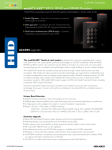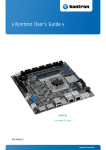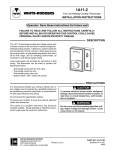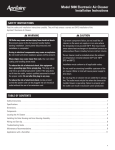Download White Rodgers 14C27S-010 Specifications
Transcript
by White-Rodgers Electronic Air Cleaner 240 Volt 50/60 Hz SST Super Slim Twin DGERS WHITE-RO TWIN SUPER SLIM AIR CLEANER ELECTRONIC Model Number 10C27S-010 14C27S-010 20C27S-010 OPERATING LIGHT OFF ON UST Universal Slim Twin Model Number 16C27S-010 OWNERS MANUAL • • • • • Installation Operation Basic SST/UST Service Guide Technical Repair Guide Repair Parts Please read and familiarize yourself with the contents of this manual before installing, operating or performing maintenance on the unit. UL Listed CSA Certified Printed In U.S.A. Part No. 37-6123D Replaces 37-6123C 0032 1. Read the Owners Manual and the Rules for Safe Operation carefully. Failure to follow these rules and instructions could cause a malfunction of filter or unsatisfactory service. 2. Follow a regular service and maintenance schedule for efficient operation. RULES FOR SAFE INSTALLATION AND OPERATION Please read instructions before installing and using the Electronic Air Cleaner. This will help you obtain the full benefit from the Electronic Air Cleaner you have selected. ! ! Installation of this unit must comply with local electric codes or other applicable codes. WARNING Review and understand local codes prior to installation. ELECTROCUTION HAZARD Shut off power at fuse panel before servicing. Failure to do so could result in serious personal injury or death. Failure to do so could result in serious personal injury or death. ! WARNING ! CAUTION CABINET AND CELLS MAY CONTAIN SHARP EDGES. WARNING Do not attempt installation of this unit unless you are familiar with the necessary tools, equipment, utility connections and potential hazards. Use care when servicing unit or handling cells. Installation should be performed only by a qualified service provider. Failure to do so could result in minor personal injury. Failure to do so could result in reduced performance of the unit, serious personal injury or death. TABLE OF CONTENTS DID YOU GET THE RIGHT SIZE AIR CLEANER Rules for Safe Installation and Operation ....... 2 How the Air Cleaner Works ............................ 3 Construction of the Air Cleaner....................... 3 Preinstallation ................................................. 4 Installation ....................................................... 6 Wiring Instructions .......................................... 7 Operation ........................................................ 8 Maintenance and Washing ............................. 8 Specifications .................................................. 9 Basic SST/UST Service Guide ..................... 10 Technical Repair Guide ................................ 11 Repair Parts .................................................. 14 Model 10C27S-010 is designed for heating or cooling blowers delivering 600 to 1200 cubic feet of air per minute (cfm.) Model 14C27S-010 is designed for heating or cooling blowers delivering 1000 to 1600 cfm. Model 16C27S-010 is designed for heating or cooling blowers delivering 1000 to 2000 cfm. Model 20C27S-010 is designed for heating or cooling blowers delivering 1600 to 2200 cfm. See specifications on page 9. BASIC TOOL REQUIRED Tin Snip Screwdriver Rule or Tape Measure Drill 2 HOW THE AIR CLEANER WORKS A Dirt particles flowing through the ducts (Figure 1) first enters the pre-filters (A) where large particles (hair, lint, etc.) are trapped. Smaller particles (smoke, dust, pollen, etc.) pass through these pre-filters and enter the ionizing section (B). Here each tiny particle receives a positive electrical charge. These charged particles then enter the collecting section (C). This section consists of a series of aluminum plates which are alternately charged negative and positive. B C Dirty Air In The positive charge of the particles cause them to be repelled by the positive plates and attracted to the negative plates where they are collected . . . just as a magnet attracts iron filings. Clean Air Out Figure 1 Clean-filtered air re-enters the supply duct system. CONSTRUCTION OF THE AIR CLEANER Not only is your air cleaner easy to install, it is also easy to operate and maintain. Its basic components, and their functions, are as follows: (See Figure 2) Cabinet Cabinet - mounts to existing duct work and houses the collecting cells and pre-filters. Pre-Filters Handle Collecting Cells - are made in two sections and perform the actual collecting of dust, dirt, and other impurities from the air. They contain the ionizing and collection sections described above. Each cell must be installed with the ionizing wires on the air entering side. Each cell must be oriented with the handles and contact button (Figure 2) toward the operator. Contact Button Pre-filters - are in two sections which are interchangeable. They serve as a pre-filter to trap large particles such as hair and lint before they can enter the cell sections. Collecting Cells Figure 2 Power Pack- contains operating light as well as the power supply that converts the 240 volt power to the high-voltage, direct current required for the collecting cell. 3 Contact Button Power Pack PREINSTALLATION Not to Exceed 20° (Interchangeable) (Interchangeable) Collecting Cell Collecting Cell Outlet Box Cabinet Power Pack Handle Air Flow Air Flow Furnace Opening Electronic Air Cleaner Opening Furnace Transition Section (if Needed) Contact Button Pre-Filters (Interchangeable) Electronic Air Cleaner Contact Button See text for Cell Removal Clearance Figure 4 Figure 3 LOCATING THE AIR FILTER Your air filter must be mounted in the return air duct of a central forced-air system, on the air entering side of your furnace. (See Figure 3 for example.) Knockouts for 3/4" Conduit (three sides) 6 7/8" Select a location that meets the following: 1. The face of the cell will be at a right angle to the air stream. 2. Allow the following clearances to permit removal of cells and pre-filters: (See Figures 4 and 5) Model 10C27S-010 - 14 inches Model 14C27S-010 - 15 inches Model 16C27S-010 - 14 inches Model 20C27S-010 - 15 inches For complete dimension data refer to Figure 5. 3. The air filter is not to be placed in the discharge of either the heating or cooling unit. 4. IMPORTANT: If atomizing spray type humidifier is used, it must be installed downstream from the air filter. If your furnace duct system has a pre-installed boot, discard front cover of boot and slide the air cleaner component inside the boot. (Applies to 14C27S-010 and 20C27S-010.) C E F D B A If furnace opening cannot be enlarged to required size, a transition sheet metal section must be used. Transition must be planned for each job. Reduction should not be more than 4 inches per linear foot, approximately 20 angular degrees (Figure 3). MODEL NO. A B 10C27S-010 14C27S-010 16C27S-010 20C27S-010 24 3/4 29 11/16 25 1/2 29 11/16 21 5/16 26 1/4 21 5/16 26 1/4 C D E 18 5/8 13 9/16 16 7/16 23 5/8 13 9/16 16 7/16 18 5/8 17 3/4 20 5/8 23 5/8 17 3/4 20 5/8 F 19 1/16 19 1/16 23 3/8 23 3/8 Figure 5 DIRECTION OF AIR FLOW THROUGH THE AIR CLEANER tions. Turn cells upside down (with the same end facing the cabinet opening). This will locate the ionizing wires at the right, and both contact buttons and cell handles will be facing the power door. Air flow direction must agree with arrow embossed on end of collecting cells. Your air cleaner is shipped from the factory with air flow from left-to-right. If this air flow is suitable for the installation, no further changes need to be made (Figure 4). For right-to-left air flow, remove both pre-filter and cell sec- After installing the cell sections, install pre-filters in cabinet tracks on the right. This will again place the pre-filters on the air entering side (on the same side as ionizing wires). 4 TYPICAL MOUNTING POSITIONS Air Flow Air Flow Air Flow Rear View Rear View Figure 6 Figure 8 Figure 7 BASEMENT FURNACE (LOWBOY) (Figure 6) HIGHBOY FURNACE (Figure 8) COUNTERFLOW FURNACE (Figure 7) Cleaner is mounted horizontally in return plenum, just above furnace. Cleaner is mounted horizontally in return duct or plenum, just above furnace. Side installation. Cleaner is mounted vertically, where return air enters side inlet of furnace. HIGHBOY FURNACE (Figure 9) Installation beneath furnace. Cleaner mounts horizontally, where return air enters from below. Raise furnace and install beneath base. Less than 7 Inches Offset At Least 9 Inches Air Flow Figure 10 OFFSET INSTALLATION (Figure 10) Figure 9 Typical use of duct offset to match air filter opening. If duct connection to furnace allows less than nine inches for mounting the air cleaner, shorten the lateral trunk, or attach an offset fitting to the elbow. Air Flow HORIZONTAL FURNACE (Figure 11) Cleaner is mounted vertically in the return duct near furnace. Figure 11 5 INSTALLATION REMOVE OLD FILTER AND DISCARD (Figure 12) NOTE: This filter may be mounted in the furnace compartment. CLEAN BLOWER COMPARTMENT Figure 12 It is suggested that the furnace blower compartment, blower and blower housing be cleaned to ensure clean air circulation. INSTALLATION Frame Duct The following is a typical installation of the air cleaner on a “Highboy” furnace (Figure 8). 1. Place the air filter cleaner on the floor. Stand it upright with the power door facing you (Figure 4). If a horizontal installation is being planned, lay the cleaner on its side, this will help you to visualize the relative location of all parts. Allow ample space for wiring and servicing the power supply box (Figure 13). 2. Release the latch, remove the power pack (by grasping handle and pulling power pack away from cabinet) and set it aside. Remove the collecting cells and pre-filters. Set pre-filters and cells aside in a safe location until the cabinet is installed. 3. Set the cabinet next to the furnace. If necessary, enlarge the opening in the furnace (if possible) to match the opening in the cabinet. If the furnace opening cannot be enlarged, a transition fitting should be used. (Figure 3). The cabinet can be attached directly (Figure 13), or a starting collar can first be fitted to the furnace inlet. A butt or slip joint can be used. Securely attach the cabinet to furnace inlet, using at least two of the mounting holes on each side of the cabinet. 4. Using butt joint, attach duct work (normally an elbow) to the upstream side of air cleaner cabinet. (Note the use of the sheet metal turning vanes inside the elbow to improve air distribution over the face of the cells.) (Figure 14) NOTE: An optional method of attaching duct work to the cabinet is to modify the cabinet (Figure 15) by bending the tabs outward at a 90° angle and attaching duct work to tabs. Power Supply Box Mounting Holes Figure 13 Air Flow Turning Vanes Figure 14 Optional method (Bend tabs outward at 90° angle) Figure 15 5. Connect the vertical duct section to the elbow. Wedge a wood block between floor and elbow for support (Figure 16). 6. Seal all joints in the return air system downstream from the air cleaner with duct tape to prevent dust from entering the air stream. Tape is usually applied on the outside of ducts, but may also be applied on the inside, or both. Transition Fittings If the air duct does not fit the cabinet opening, a transition fitting should be used. Gradual transitions are preferred for greatest efficiency. Not more than four inches per linear foot (approximately 20° angle) should be allowed (Figure 3). 6 WIRING INSTRUCTIONS ! 7. With the cabinet installed, the air cleaner can now be wired to electrical input source. ! CAUTION Electrical power to the furnace should be turned off or disconnected at the circuit breaker. WARNING 8. The air cleaner must be wired through the furnace controls to a 240 VAC 60 Hz electrical source. Ensure that electrical connections to the air cleaner are installed properly (see Figure 17). The air cleaner should not have power unless the furnace blower is on. Installation of this unit must comply with local electric codes or other applicable codes. Review and understand local codes prior to installation. Failure to do so could result in serious personal injury or death. Vertical Section Cooling Fan Relay (External) Electronic Air Cleaner N.C. Tape All Joints Hi N.O. 240 Volt 2 Speed Fan N.O. N.C. N.C. Brown N.O. Wood Block C Lo 240 Volt 60 Hz N.O. 240 Volt Relay (OFF) (Customer Supplied) Fan Control (Open) 240 Volt 60 Hz Cooling Mode - Fan Operating in Hi Speed Figure 16 Cooling Fan Relay (External) Floor Electronic Air Cleaner N.C. Hi N.O. 240 Volt 2 Speed Fan N.O. N.C. N.C. Brown Conduit N.O. C Lo 240 Volt 60 Hz Fan Control (Closed) N.O. 240 Volt Relay (ON) (Customer Supplied) 240 Volt 60 Hz Heating Mode - Fan Operating in Low Speed Figure 17 Duct Electronic Air Cleaner Figure 18 7 9. Remove junction box cover and install the required bushing into the 3/4 in. Knock out. With the supply voltage turned off, route three (3) wires into junction box for connections. (See Fig. 19.) Insure all wires are clamped, wire connectors properly installed and grommets used to prevent wire abrasion. 10. With the cabinet Installed, reinstall pre-filter(s) and collecting cell(s) (Figure 20). NOTE: The contact button and handles on the cell must be facing you and ionizing wires must be on the air intake side. 11. Install the power pack as follows: Engage the lip on lower inside edge of power pack in the flange on cabinet and carefully close the power pack, making sure that the electrical connector prongs on the power pack enter the slots in the socket on cabinet. When the power pack is fully in place, engage the latch and snap it closed. Hot Hot Grounding Conductor Front View Figure 19 Cabinet Pre-Filters Handle Contact Button Collecting Cells Contact Button Power Pack Figure 20 OPERATION 1. With the 240 VAC power turned on at the circuit breaker for the furnace, push the air cleaner ON-OFF switch to the “ON” position (Figure 21). 2. With the furnace blower running, the air cleaner will be operating. An arcing or “snapping” sound may be heard. This will occur occasionally, however the unit is operating properly. 3. With the furnace blower running, the Operating Light should be ON. If the Operating Light is not ON this signifies that the cells need washing, or that trouble exists in the unit. If, after washing the cells, the Operating Light stays off, the cell could be wet, improperly placed in the cabinet or may need servicing. Operating Light On-Off Switch NOTE: An occasional flicker of the light accompanied by harmless sparking or snapping noise may occur. This is caused by trapping large particles of dirt. If arcing is continuous, the cells should be washed or checked for service problems see Basic SST/UST Service Guide. Figure 21 8 A moderate amount of arcing or “snapping” may occur at this time, which will indicate that the cell(s) are still damp. If the noise is objectionable, push the ON-OFF switch to the “OFF” position and allow additional time for cell(s) and pre-filter(s) to dry. In some cases the Operating Light will remain OFF during this initial activation of the air cleaner, and this would indicate that the cell(s) are not completely dry. The Operating Light should remain ON while the furnace fan is running once the drying is complete. MAINTENANCE AND WASHING ! CAUTION CABINET AND CELLS MAY CONTAIN SHARP EDGES. Use care when servicing unit or handling cells. REPLACING AN IONIZING WIRE Failure to do so could result in minor personal injury. If an ionizing wire should break, it can be replaced as follows: For maximum efficiency your air cleaner cell(s) and prefilter(s) should be inspected once a month and cleaned when necessary. Cleaning will usually be required every one to three months, depending upon the particular household circumstances. When cleaning is required the following procedure should be used: 1. Remove all pieces of broken wire. Make sure supports at each end are in good condition and not bent out of shape. 2. Hook the new wire onto the support at one end. 3. Hold your finger against the support at the other end (Figure 22) and hold the ionizing wire between thumb and forefinger as shown or use needle nose pliers. Press inward on spring support. Hook end of wire over small tab at end of support and release. Make sure wire is securely anchored at each end. CLEANING THE CELLS 1. Turn the air moving system “OFF.” 2. Push the ON-OFF switch on the power pack to the “OFF” position (Figure 20). Wait 15 seconds and both the power pack and the collecting cell(s) will be automatically discharged. 3. Release the latch on top of power pack and pull the power pack straight away from cabinet at the top. Then lift pack out of ledge at bottom edge of cabinet. Set power pack aside. 4. Remove the cell(s) and pre-filter(s) from cabinet. Using a solution of warm water and low sudsing detergent, soak cell(s) and pre-filter(s) for 20 to 30 minutes. NOTE: Ionizing wires may become coated causing loss of cleaning ability by the collecting cell. Using a damp cloth, wipe each ionizing wire, exercising care not to damage them. 5. Remove the cell(s) and pre-filter(s) from solution and rinse thoroughly with clean water. 6 Allow cell(s) and pre-filter(s) to drip dry for a minimum of 2 hours. Cell(s) and pre-filter(s) may be tipped at a slight angle to expedite the drip-dry process. 7. Reinstall the cell(s) and pre-filter(s) in the cabinet. 8. Replace the power pack. Turn furnace fan on. After 30 minutes push ON-OFF switch on the power pack to the “ON” position. Support Ionizing Wire Figure 22 9 SPECIFICATIONS SPECIFICATIONS 10C27S-010 14C27S-010 16C27S-010 20C27S-010 Rated Capacity 600 - 1200 cfm 1000 - 1600 cfm 1000 - 2000 cfm 1600 - 2200 cfm Max. Pressure Drop .08 in. W.G. .08 in. W.G. .12 in. W.G. .09 in. W.G. Cell Weight (2) 7 lbs. each (2) 9 lbs. each (2) 9 lbs. each (2) 9 lbs. each Power Pack Weight 9 lbs. 9 lbs. 10 lbs. 10 lbs. Unit Weight 35 lbs. 42 lbs. 38 lbs. 45 lbs. Power Consumption 40 Watts (Max) 40 Watts (Max) 40 Watts (Max) 40 Watts (Max) Electrical Input 240 VAC 50/60 hz. 240 VAC 50/60 hz. 240 VAC 50/60 hz. 240 VAC 50/60 hz. Electrical Output 1.0 Ma @ 6450 VDC (nom) 1.2 Ma 1.5 Ma 1.7 Ma Max. Ozone Output .05 ppm .05 ppm .05 ppm .05 ppm Temperature Rating 40° F to 125° F 40° F to 125° F 40° F to 125° F 40° F to 125° F BASIC SST/UST SERVICE GUIDE This guide will cover most homeowner complaints. If, after checking the items listed, the unit still fails to operate properly, contact the nearest Authorized Service Center. SERVICE INDICATION SERVICE CHECKS ON/OFF switch “ON” Blower ON Operating Light ON Unit functioning Normally ON/OFF switch “ON” Blower ON Operating Light OFF 1. Power is not being supplied to air cleaner. A. Check fuse or circuit breaker. B. Ensure power pack is properly installed and latched. 2. Collecting cell shorted - Turn power Off - Remove power pack - Remove collecting cells - Replace power pack - Restore power (ensure blower is operating). A. If Operating Light comes ON check cells for bent plates, loose ionizing wire(s) or cracked insulator(s). B. If Operating Light remains OFF, malfunction is in the power pack. (See power supply Checkout Procedure). Excessive arcing during normal operation Operating Light may blink 1. Wet collecting cell. A. Allow cell(s) to dry after cleaning before applying power. 2. Damaged collecting cell(s). A. Remove cell(s) and inspect for bent plates, loose ionizing wire(s), cracked insulator(s), etc. 3. Collecting cells dirty. A. Clean cells as instructed in this manual. 4. Faulty power supply (see power supply checkout procedure) 10 TECHNICAL REPAIR GUIDE All voltage measurements indicated can be made with a high voltage D.C. probe and a general purpose volt ohm meter. For example: Simpson 260 or equivalent. WARNING ! Do not attempt installation of this unit unless you are familiar with the necessary tools, equipment, utility connections and potential hazards. NOTE: All tests to be performed with the Ozone Reduction Jumper intact. NOTE: When servicing the power pack components, all wiring must be routed to factory specifications. Installation should be performed only by a qualified service provider. Failure to do so could result in reduced performance of the unit, serious personal injury or death. This guide contains service checks to assist service personnel in locating and correcting any malfunction that might occur to render the air cleaner ineffective or inoperative. The air cleaner has been designed with replaceable components, such as the high-voltage power supply and air flow switch. This allows the serviceman to replace a faulty component rather than attempt repairs of such components in the field. 240 VAC Connector L2 Power Pack Assembly Cover Assembly Operating Light ON/OFF Switch Orange Input voltage: 240 VAC 50/60 Hz. Output to light: 1.5 to 2.5 VDC H.V. Output: 6450 VDC (nom) Input Transformer Gnd Power Supply Specifications The solid-state power supply is not designed for individual component part replacement and must be replaced as a complete "snap-in" unit. White L1 Collecting Cell Specifications Red Cell Contact & Insulator 1000 cfm - 1.0 Ma @ 6450VDC 1400 cfm - 1.2 Ma @ 6450 VDC Blu Wht Wht/Brn Blk 1600 cfm - 1.5 Ma @ 6450 VDC Power Supply 2000 cfm - 1.7 Ma @ 6450 VDC Figure 23 11 POWER SUPPLY CHECKOUT PROCEDURE OZONE REDUCTION All electronic air cleaners typically produce a small amount of ozone that is within established limits. Some customers may notice an odor especially at high altitudes or low air flow rates. 1. Turn power switch to the “OFF” position and remove the power pack from cabinet. 2. Place power pack on a well insulated workbench. Connect meter negative (-) lead to the sheet metal chassis and the high voltage probe to high voltage contact on back cover of power pack. Connect 240 VAC power to power pack using an extension cord and turn power switch to the “ON” position. Keep hands and tools away from high voltage contact. 3. If Operating Light comes ON and output voltage is between 6100 and 6800 VDC, power supply is good. 4. If voltage is good but Operating Light does not come on, replace Operating Light. This power supply has a “hairpin” shaped jumper wire labeled W1 (see Fig 24) that can be cut and separated in case of such complaints. This will cause the power supply to limit the maximum operating power to a lower level. W1 Cut and separate Ozone Reduction Jumper CELL TEST 1. Place collecting cell on a well insulated workbench with the cell contact button pointing upward. 2. Select a power pack (with ozone reduction jumper intact) that reads between 6100 and 6800 VDC at the cell contact with no cell attached. 3. Place power pack on top of collecting cell ensuring that there is proper contact between the cell contact on the power pack contact. 4. Using an extension cord, apply 240 VAC to power pack. Turn power switch to “ON” position. 5. Connect meter negative (-) lead to metal frame of collecting cell. Use high voltage probe to measure voltage at collecting cell ionizer or cell plates. Voltage should be 6100 to 6800 VDC. NOTE: A new “out-of-box” cell may cause the voltage to be lower than normal for a short period of time. To obtain a more accurate measurement, “age” the cell by applying high voltage to the cell for 15 to 30 minutes. 6 If voltage is below 6100 VDC, check cell for foreign objects, bowed/bent/loose plates, broken ionizing wires or cracked insulators. Wash cells if required. If Operating Light remains OFF, replace collecting cell. WHT/BRN E3 BLK LINE Ozone Reduction Jumper Figure 24 12 E2 NOTES 13 REPAIR PARTS 14 14 REPAIR PARTS PARTS LIST FOR ELECTRONIC AIR CLEANERS When ordering repair parts, always give the following information as shown in this list. 1. The PART NUMBER 2. The PART DESCRIPTION 3. The MODEL NUMBER 4. The NAME OF ITEM - Electronic Air Cleaner. Always order by “PART NUMBER” . . . Not by “ITEM NUMBER” ITEM NO. 1 2 3 4 5 6 7 8 9 10 11 12 13 14 PART NUMBER DESCRIPTION 15 Cabinet Pre-Filter Collecting Cell Junction Box Cover * Screw #6 x 3/8 Connector, Female Power Pack Assembly Cell Handle Ionizing Wire Light Switch Power Pack, Cabinet Only Connector, Male Power Supply includes Input Transformer Cover, Power Pack 16 17 † Charcoal Filter (with mounting clips) † Manual 10C27S-010 14C27S-010 16C27S-010 20C27S-010 N/A • F825-0431 • F811-0398 F838-0072 -----F818-0046 F858-0977 F832-0039 F843-0484 F844-0130 F876-0202 N/A F827-0017 F858-0975 N/A • F825-0432 • F811-0397 F838-0072 -----F818-0046 F858-0977 F832-0039 F843-0484 F844-0130 F876-0202 N/A F827-0017 F858-0975 N/A • F825-0337 • F811-0321 F838-0072 -----F818-0046 F858-0976 F832-0039 F843-0500 F844-0131 F876-0202 N/A F827-0017 F858-0975 N/A • F825-0338 • F811-0319 F838-0072 -----F818-0046 F858-0976 F832-0039 F843-0500 F844-0131 F876-0202 N/A F827-0017 F858-0975 F820-0098 F820-0098 F820-0220 F820-0220 F825-0466 37-6123 • F825-0467 37-6123 • F825-0468 37-6123 • F825-0469 37-6123 * Standard Hardware Item • Two (2) Required † Not Shown 15 NOTICE TO CONSUMERS White-Rodgers Electronic Air Cleaner Dear Consumer; White-Rodgers would like to thank you for purchasing a White-Rodgers Electronic Air Cleaner or product containing a White-Rodgers Electronic Air Cleaner. Although WhiteRodgers does not extend a warranty directly to consumers, White-Rodgers does extend a warranty to Wholesalers and Original Equipment Manufacturers who use White-Rodgers Products. To obtain more information about how your Wholesaler or Original Equipment Manufacturer’s warranty may benefit you, please contact your Wholesaler or Original Equipment Manufacturer. Sincerely, White-Rodgers Controlling America’s Indoor Comfort White-Rodgers Division, Emerson Electric Co. 9797 Reavis Road, St. Louis, MO 63123-5398 314-577-1300 • FAX 314-577-1517 www.white-rodgers.com
















